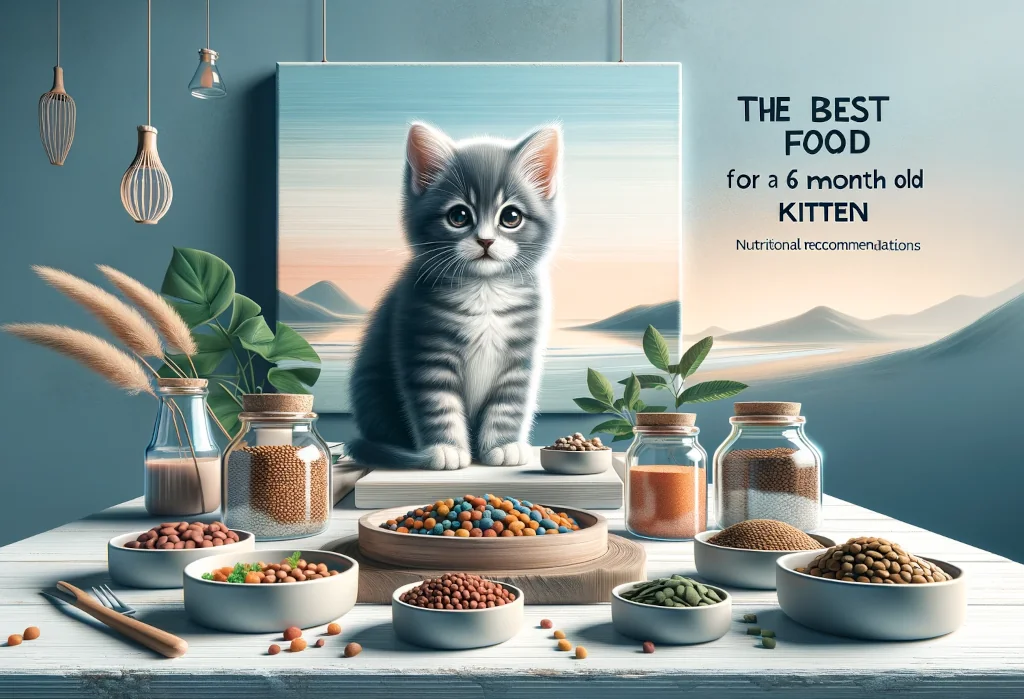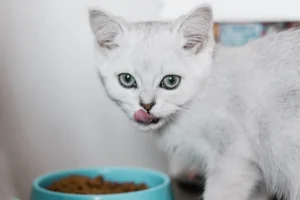Disclosure: We may earn a commission from helpful, relevant links in our content. No cost to you. See our privacy policy.
Seeing your kitten zoom around the house is one of life’s purest joys, right up there with finding that perfect bite of food. But when it comes to feeding your furry missile, the endless options can make you feel more like a confused hunter than a proud pet parent.
In this post, we’re dishing up everything you need to know about choosing the best food for your 6-month-old kitten, ensuring they grow up healthy, happy, and ready for any adventure.
Key takeaways:
- Choose kitten food rich in proteins, essential fats, and supplements like DHA and taurine to support growth and development.
- Balance your kitten’s diet with both wet and dry food to capitalize on the benefits of each, ensuring hydration and dental health.
- Stick to a consistent feeding schedule of three meals a day, adjusting portions based on your kitten’s growth and activity level, and always consult with a vet to tailor to your kitten’s needs.
What Should You Look for in Kitten Food?
When your furball is around 6 months old, its nutritional needs are nothing short of crucial. Starting off, high protein content is a must-have in kitten food. Protein aids in robust growth and supports muscle development. Then, there’s the essential fatty acids, like omega-3 and omega-6, which are vital for energy, and also give their coat that silky, advertisement-worthy sheen.
Let’s not forget about vitamins and minerals. These are the building blocks for bone strength, immune support, and overall health. DHA (Docosahexaenoic Acid) plays a critical role in brain development, ensuring your kitten’s cognitive functions are sharp and responsive. And taurine – this amino acid is a non-negotiable for kitten food, as it supports heart and eye health.
In summary, when scanning the shelves or browsing online, prioritize foods packed with proteins, enriched with essential fats, and supplemented with the right vitamins and minerals. It’s the formula for a happy, healthy, bouncing kitten.
Wet Food or Dry Food: What’s Better for Your Kitten?
The wet vs. dry food debate has been longstanding. Here’s the scoop: both have their place in your kitten’s diet.
Wet food is a fantastic source of hydration. Considering cats aren’t known for their love of water, incorporating wet food can ensure your furry friend stays hydrated. It’s generally richer in protein and fats, closely mimicking a natural carnivorous diet. Plus, let’s be real, many cats find it more palatable.
On the flip side, dry food offers the convenience we can’t ignore. It’s easy to store, typically more affordable, and can be left out for free-feeding without spoiling. Additionally, munching on those dry kibbles can help in reducing tartar buildup, contributing to better dental health.
Mixing both can give your kitten the best of both worlds. A diet balanced in wet and dry food can strike a perfect harmony between hydration, nutrition, and convenience. Just remember, the transition between the two should be gradual to avoid gastrointestinal upsets.
Top Picks for Wet Kitten Food
When it comes to wet food for your 6-month-old kitten, not all cans are created equal. Choose products labeled as “Complete and Balanced” by the AAFCO to ensure they meet the nutritional standards. Here are our top picks that not only meet these guidelines but exceed expectations:
-
Royal Canin Feline Health Nutrition Kitten Instinctive
– Formulated specifically for kittens, this wet food comes in a soft mousse texture that’s easy for young kittens to eat. Packed with proteins, it supports muscle development while also being enriched with DHA for brain health. -
Blue Buffalo Healthy Gourmet Kitten Chicken Entrée
– Made with real chicken as the first ingredient, this wet food is rich in quality protein and natural ingredients. It’s enhanced with vitamins, minerals, and other essential nutrients, promoting overall health and growth. -
Wellness CORE Natural Grain Free Turkey & Chicken Liver Pate
– This grain-free option provides high-quality proteins and a mix of nutrients essential for your kitten’s development. It’s also rich in DHA for cognitive development and has a taste kittens love.
Unique Pick: Many might not consider this, but incorporating a Probiotic Supplement into your kitten’s wet food can promote digestive health and boost the immune system. While not a direct food recommendation, it’s a unique insight that can significantly impact your kitten’s health positively. Products like Purina FortiFlora Feline Probiotic Supplement can be mixed into the wet food, aiding in maintaining the balance of good bacteria in the gut.
When venturing into the world of kitten nutrition, it pays to be informed. Each kitten is unique, and their preferences and nutritional needs can vary. Always consult with your vet to personalize your kitten’s diet according to its specific health requirements and lifestyle.
Best Choices for Dry Kitten Food
When hunting for the perfect dry kitten food, you’re essentially looking for a culinary gold mine packed with nutrition, taste, and just the right kibble size. Let’s face it, our little fluff balls are growing at the speed of light, and their diet plays a crucial role in ensuring they develop into strong, healthy, and happy adult cats. Here are a few top picks that check all the boxes for your 6-month-old fur baby:
-
Royal Canin Kitten Dry Food : Specifically designed for kittens up to 12 months old, this food features a blend of antioxidants and vitamins to support a developing immune system and growth. The small, easy-to-chew kibble is perfect for tiny mouths, ensuring your kitten can enjoy their meals comfortably.
-
Hill’s Science Diet Kitten Indoor Dry Cat Food : Tailor-made for the indoor lifestyle, this food offers a balanced nutrition with high-quality protein for lean muscle growth. It’s enriched with fish oil to provide omega-3 fatty acids for brain development.
-
Blue Buffalo Wilderness Kitten Chicken Recipe : Packed with real chicken, sweet potatoes, and other wholesome ingredients, this grain-free option is great for the little adventurer in your home. It’s rich in protein and contains DHA for cognitive development.
-
Unique Pick – Forging Bonds Through Feeding : Now, here’s something that’s often overlooked but is golden advice—turn mealtime into bonding time. While the focus is usually on the nutritional content (and rightfully so), using a puzzle feeder for your kitten’s dry food can make feeding time fun, mentally stimulating, and a bonding activity. Puzzle feeders encourage natural hunting instincts and can help prevent overeating, making mealtime both enriching and beneficial for weight management.
How Often and How Much Should You Feed Your Kitten?
Getting the portion size and feeding schedule right is almost as crucial as the food itself. At 6 months old, your kitten is like a teenager—full of energy and growing rapidly. Here’s a general guide to help you navigate through their dietary needs:
-
Feeding Schedule : At this age, transitioning to three meals a day is ideal. It mimics their natural feeding habits and supports their energy levels throughout the day. Consistency is key, so try to stick to the same times every day.
-
Portion Sizes : This can be a bit tricky as it varies depending on the kitten’s size, activity level, and their specific dietary needs. A general rule of thumb is about ⅓ to ½ cup of dry kitten food daily, spread across the three meals. However, always check the feeding guidelines on the specific food you’re using as a starting point.
-
Monitoring Weight and Adjusting Portions : Keep an eye on your kitten’s weight and body condition. They should be lean, not skinny or chubby. If you notice your kitten is putting on too much weight, slightly reduce the portion sizes. Conversely, if they seem too lean or are not gaining weight, you may need to increase their food intake. Remember, every kitten is unique, so adjustments are normal.
-
Stay Hydrated : Always ensure your kitten has access to fresh, clean water. Proper hydration is essential, especially when feeding dry food.
In summary, choosing the right food for your kitten involves considering nutritional content, kibble size, and making mealtime a delightful experience. Adjusting feeding schedules and portion sizes to suit their growth needs is also key to fostering a healthy development. Remember, when in doubt, consulting with a veterinarian can provide personalized guidance tailored to your kitten’s specific requirements. Happy feeding, and here’s to the health and happiness of your furry friend!
Alex, a passionate animal lover, has experience in training and understanding animal behavior. As a proud pet parent to two dogs and three cats, he founded AnimalReport.net to share insights from animal experts and expand his knowledge of the animal kingdom.





